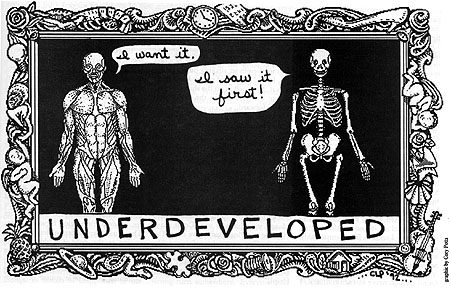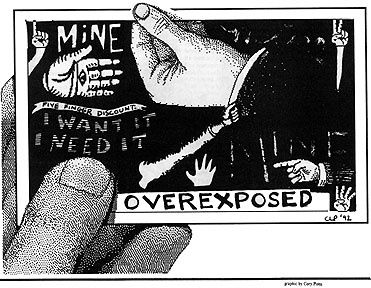|
INTELLECTUAL
PROPERTY RIGHTS?
A
Debate
Treaty
Favors TNCs
Despite
being cast as the lone villain in a global village, the United States
had a surprising ally in opposing the controversial biodiversity treaty
at the Earth Summit. Indigenous people from the tropical forests of the
world took a similar position against the treaty in a meeting just before
the official summit.
Like
the United States, the Indians want a guarantee of respect for "intellectual
property rights" or patents. This convergence highlights a fatal
flaw in the convention on biological diversity.
The
treaty will be signed by governments seeking control of burgeoning markets
and profits in biotechnology. But it will bypass the only players who
really count in the production and marketing process--indigenous people
who know how to tap the great diversity of the tropical forests, and industries
that can bring forest products to market.
Treaty
advocates in Rio cited what they call a clear-cut case of "bioimperialism."
The multinational pharmaceutical giant, Merck & Co., manufactures
a treatment for glaucoma based on an alkaloid extracted from jaborandi,
a bush found exclusively in the Amazon. Kayapo and Guajajara Indians,
who first used the plant as a medicine, now harvest and sell the leaves
to Merck under conditions anthropologists describe as "near slavery."
In Germany, the alkaloid is refined and made into eyedrops that Brazil,
among other countries, imports.
The
most effective way to undercut this bioimperialism would be to make sure
that those who first brought the jaborandi to the attention of international
chemists--the Indians--receive patents and royalties. Instead, the biodiversity
treaty compels the industrialized nations to compensate Brazil and other
governments of developing nations where the raw materials are found.
Advocates
portray the treaty controversy as another round in the battle between
North and South. The North seeks to protect biological patents and profits
while insisting that the South preserve its tropical forests. And the
South protests attempts to lock up its genetic resources in patents and
preserves while insisting that the North share the wealth generated from
these raw materials.
Ironically,
what this debate ignores is the new common ground that has emerged between
the "North of the North"--the biotechnology and pharmaceutical
industries of the developed world--and the "South of the South"--the
indigenous people of the tropical forests.
Roughly
three-quarters of the compounds in the modern global pharmacopoeia originally
derived from plants "discovered" through research on the use
of plants by indigenous people. The value of such genetic resources is
predicted to reach $50 billion by the year 2000. Yet it is estimated that
only 2% of the plants in the Amazon alone have been studied by scientists.
The indigenous people of the tropical forests hold the keys to much of
the rest.
Ethno-botanists
and pharmacologists have only begun to tap the complex database of indigenous
empirical knowledge. When their knowledge is used for profit, indigenous
people say they should have just as much right to a patent for "intellectual
property rights"--knowledge of how to use or process a plant--as
the pharmaceutical companies now enjoy.
To
be successful, a treaty on biodiversity would have to include not only
the governments of the North and the South, but also indigenous people
and companies that use their biological resources and knowledge. By giving
all the power over biodiversity to governments--many of which, like Brazil,
have a dismal track record of honoring either patents or indigenous property
rights--the biodiversity treaty is set up to fail.
U.S.
objections to the treaty cover only half of the equation--the "intellectual
property rights" of biotechnology companies. The other half involves
recognizing indigenous people's demand to those same rights.
Respecting
the patent rights of both would provide a financial incentive for conserving
and developing biodiversity at the ground level in the South. And royalties
on patents would provide the return flow of hard cash from the North to
the South that new markets for genetic wealth will generate.
Many
delegates protested that it is too late to amend the biodiversity treaty.
But a fundamentally flawed treaty should not have been signed in a rush
to save the appearance that something was being accomplished at the Earth
Summit. Mutual recognition of property rights would do more concrete good
than all the high-minded rhetoric about preservation and equity in the
current biodiversity treaty.
--Jon
Christensen

Intellectual
Property Rites
There
has recently been a flurry of discussion around Intellectual Property
Rights (IPRs, in the jargon of the day). At the recent Earth Summit the
United States refused to sign a treaty on biodiversity because of proposed
restrictions on patents of pharmaceuticals derived from plants. Curiously,
however, the advocates (e.g. the anthropologists of Cultural Survival)
are not limited to the profit-hungry corporations; there are those who
see IPRs as a possible tool in giving indigenous people more control over
the use of traditional lands.
It
is not an auspicious time for the idea of intellectual property. Computer
programs and data which can be copied and distributed electronically;
the ubiquitous copy machines and faxes; audio and video (re-)recording
devices; and countries which are not members of various treaty conventions
on copyrights and the like (India, China, etc.); the use of "sampling"
in music and "back-engineering" in technology; have all made
a mockery of this extension of property relations into the realm of intellectual
creation.
Even
within the United States there is much conflicting law and practice. The
original concept of copyrights has its origin in the idea that ideas must
not remain the exclusive property of the "inventor," for, as
Jefferson wrote, "one may take another's idea without leaving the
first poorer" (his analogy of one candle lighting another comes to
mind). Such "ownership" was limited to the author's life plus
a fixed number of years; patent law explicitly requires the public statement
of the invention and (often) the best way of producing the object, and
allows the inventor a limited period of control. Some of the basic concepts
of patents included denying patents for natural products, for inventions
which were obvious or commonplace, and for other people's creations.
Recently,
however, there has been a burgeoning of US patents and copyrights on more
subtle concepts: processes and methods, as well as naturally occurring
chemicals and substances. People (usually corporations, or their proxies)
have recently been awarded patents on algorithms (which previously have
been regarded as "discovered" rather than invented), and on
"new" biological organisms and species (which are, in fact,
only new combinations of previously existing genetic material). The relentless
drive for profit and control has even led to such absurdities as the "look-and-feel"
law suits of Apple and Microsoft dealing with concepts of controlling
computers which neither party devised (Xerox's Palo Alto Research Center
has that distinction). And in an apparent reversal of the idea of not
patenting natural products, two corporations have been granted patents
on chemicals (one derived, one synthesized) from the Brazilian Neem tree.
Many of uses of chemicals from such plants have long been known to natives
of the area for exactly the same reasons; granting patents would seem
to violate the principle that commonplace uses may not be patented. Although
the US has always regarded the rest of the planet as its hunting ground,
this usurpation of indigenous discoveries would also seem to be patenting
someone else's work.
Some
recent advocates of IPRs argue that because many of the biological products
are derived from plants known by indigenous people (and sometimes used
by them for the same purpose) the original "discoverers" (and
often inventors, for the use of these drugs is often the result of generations
of effort)should be awarded commensurately. Some have also argued that
food crops may be seen this way: the result of centuries of refinement
and experimentation by indigenous people around the world. Some even see
this archaic legal concept as a possible reinforcement of these people
in their fight for survival and control over their lands.
Perhaps
. . .but this begs the question of whether such "rights" are
legitimate. It can be argued that even as such ideas are being hailed
in the "third" world, they are being shown as outmoded impediments
in the techno-sphere: information moves faster, and with more ambiguous
ownership all the time. Indeed, given that human knowledge is such an
enormously socialized (and historical) creation, no invention can be said
to be independent. The need for capital to harness such creations to make
a profit is indisputable, and we should never forget the crucial question:
"quo vadis?" ("who gains?").
Nor
am I hopeful about the possibilities of enforcing such putative rights
as may be won by what-ever collective group. The ability to enforce such
contracts is a precise measure of social power; groups with no power will
find those rights insupportable. Countries like Brazil, with its long
history of mistreatment of indigenous peoples, no less than the US, which
has a long and almost unbroken record of ignoring its treaties with North
American Indians, are not promising arenas for indigenous people to play
out power relations. When one side writes the laws, owns the courts, and
licenses the lawyers, as well as allowing the vast budgets of the corporations
free play, the other side, even if it is able to buy a few attorneys,
cannot be said to be an equal. Bakunin's comment is relevant: "The
law, in its majestic impartiality, forbids the rich as well as the poor
from sleeping under bridges, begging, and stealing bread."
Casting
the importance of nature in terms of property relations strengthens the
abhorrent concept that wilderness and primal nature deserve protection
because they are--or might be--useful.
There
are further problems with imposing this western model on traditional societies:
just as some North American tribes were never granted recognition by the
US government because they had no leaders, the requirements of marketing
and legal representation of IPRs will impose unique stresses on indigenous
communities. Given movements towards control of traditional music and
copyrighting materials, etc., the only aspects of traditional life that
will survive may well be corporation's names, and a few patented commodities.
Imagine a scenario in which some village elder sues another for copyright
violations for performing a traditional song; perhaps in the name of ancestral
spirits.
Such
talk of "rights" also ignores some crucial questions about what
the concept means: such "rights" are certainly not immutable
things handed to us by nature; to the extent that there are any rights,
it is because the common folk have fought for them. They were not, and
never will be, given to us by benevolent masters. Those rights have always
proved to be worthless in the absence of people willing to defend themselves
(often outside of any legal process).
To
frame our thinking about the exploitation of the other parts of the world
in terms of ethics among property owners is to ignore the imperative of
business: to make money. To try to use the very tools of business (law,
property rights) to stop business, can't work.
It
seems most unlikely that the road to human freedom and dignity passes
through a courtroom and patent office. I regret that I have no better
ideas for helping the poor people of such "developing" parts
of the world as Brazil, but the idea that the concept of property, extended
to more parts of the world, and to new "objects," will help
preserve the parts not yet destroyed by the world capitalists, is not
a sensible one. Perhaps this can be a tool of limited use, but to present
it uncritically does us all a disservice.
--Primitivo
Morales

REPLY
TO PRIMITIVO MORALES
Maybe
this is not a very auspicious time (or place) to speak in favor of intellectual
property. Of course, the argument could be extended. Across the political
spectrum, we seem to be facing the 21st century with ideas inherited from
the 19th century. It's fun to run in ideological circles, dancing with
romanticism, communism, anarchism, nihilism, capitalism, post-this-and-thatism,
careering from optimism to pessimism and back again, and throwing up our
hands when pressed for direction. But have we learned anything in the
20th century? Perhaps something about pragmatism.
In
the first place, the argument in favor of recognizing the intellectual
property rights of indigenous people was made by them, not us. Of course,
one can trace the concept's history to the door of capitalism. But it
is a system most indigenous people have trucked with quite extensively
over the last century or more.
Intellectual
property rights may be an argument of the moment. More likely, indigenous
people see property as a tool they can grasp to increase their own power.
In any case, the demand for intellectual property rights emerges logically
from their demands for recognition of their property rights in land as
well, which have also been an inconvenience to some. Now they seek recognition
of their knowledge, which until lately usually has been devalued even
as it has been used by profiteers.
Unfortunately,
pharmaceutical companies such as Merck and national governments such as
Costa Rica are quickly cutting deals leaving out the local people who
live in the tropical forests that are the sources of much of the world's
biodiversity. And why not? The messy world of people vying for life in
some backwoods is really just so much trouble. You're so right. There
are too many practical problems with identifying the "inventors"
of traditional knowledge, not to mention compensating often fractious
communities.
But
indigenous people have an inconvenient way of asserting themselves, especially
it seems as we confront the millennium with such an intense love-hate
relationship with technology and the nation state. Even as many late 20th
century thinkers continue to see indigenous people somehow representing
a state of society outside the market system, their demand for property
rights presents a nagging problem.
Perhaps
global positions--such as worshipping or demonizing the market in all
cases--attempt to reach too far. Property rights can be a basic means
of preserving local control. But property rights are clearly not a panacea,
as history shows.
Information--and
for that matter all kinds of property--may want to be free, as they like
to say in Silicon Valley at the end of the 20th century. But property
has costs and consequences and if you're lucky maybe benefits and profits.
As a writer, marketing my words, I stand on the side of intellectual property
rights, even though I will write for free. There are more important things
than money and property. But that doesn't mean we have to turn our backs
on them.
--Jon
Christensen

|
